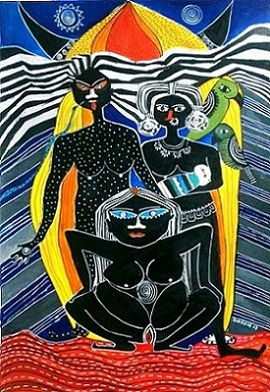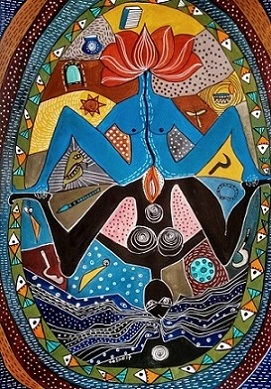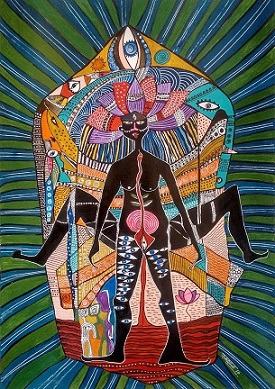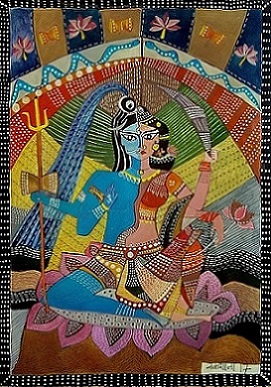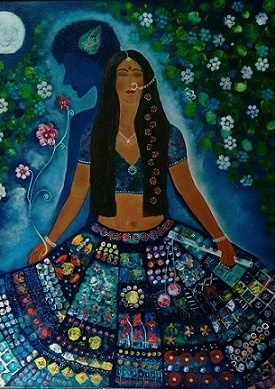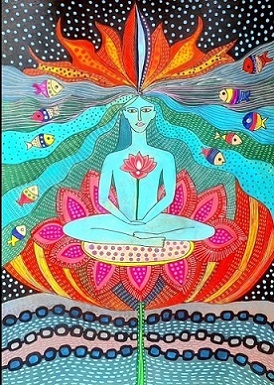
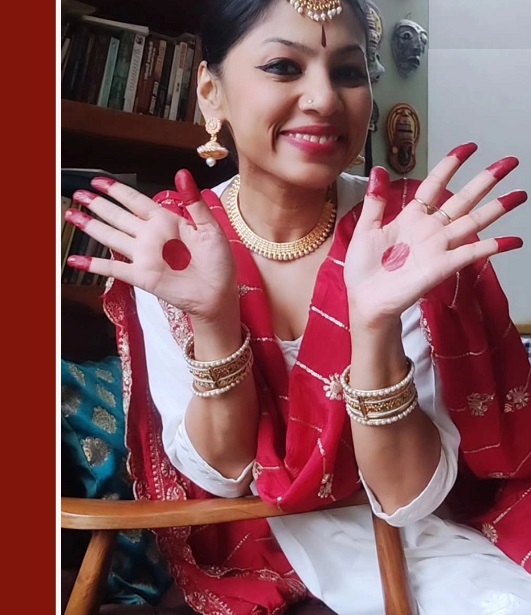
Rukshana Tabassum
She’s lively, cheerful, and energetic as a person. She’s sincere and disciplined when it comes to work. She learns bharatanatyam and yoga. She paints. Incessantly. On paper. On canvas. On walls. Anywhere. Everywhere. And last month, Rukshana Tabassam finally had her debut solo art exhibition. At the Art Bungalow, in Mumbai. Initially scheduled for a fortnight, it got extended due to public demand. She makes films too. That’s how I met her, years ago. I had played one of the lead roles in a children’s feature film that she wrote and directed. It went on to win her the second of her two National Film Awards.
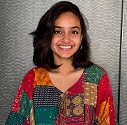
Adria Cardoza
BSc (Hons.), Integrative Nutrition & Dietetics
Rukshana, before we dive into your many creative practices, how would you describe yourself… by who you are within?
At my core, I’m a seeker—someone who’s deeply curious about life, death, and everything that connects the two. I try to stay open, to observe, to feel, and to keep learning from the world around me.
What role did your family or culture play in nurturing your passions?
In my neighborhood, every child was immersed in some form of art—be it dance, music, or painting. My parents, too, were passionate lovers of all art forms, which further nurtured my interest. Cultural programs were a regular feature in our school and town, creating an environment where artistic expression was celebrated. It felt natural for me to follow suit and learn something myself.
What drew you into exploring the different art forms that you currently practice?
I started learning dance and painting when I was about six. I used to love watching the seniors perform Bharatanatyam in school—there was something captivating about it. I told my parents I wanted to learn, and they put me in a class. That’s how it started. Over time, I found myself deeply drawn to storytelling. Since I was already immersed in dance and visual art, that creative foundation naturally guided me toward filmmaking.
How do you feel when you’re dancing?
Ecstatic. It’s a deeply divine experience. Like fully immersing in the rasas. Feeling each emotion intensely and honestly. In those moments, I feel present, alive, and incredibly grateful to the universe.
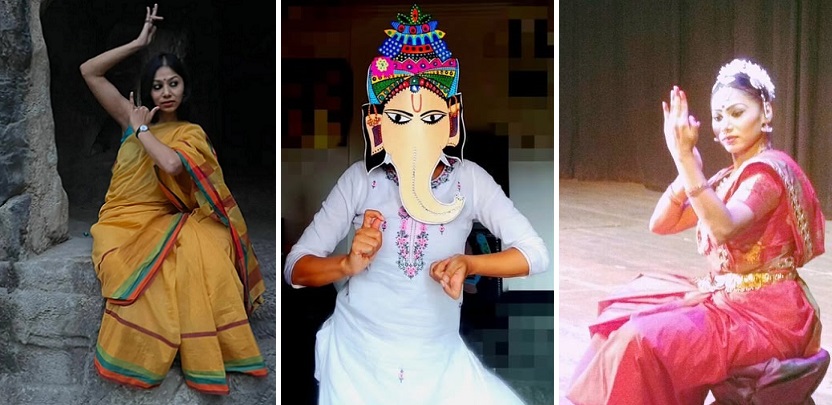
What inspired you to delve into filmmaking?
This happened quite by chance. I was interning at an ad agency when I met an ad filmmaker who kindly took the time to listen to one of my ideas for a TVC. He casually suggested, “Why don’t you explore filmmaking?” That sparked something. It sounded interesting, so I started researching on film schools and learning more about the craft. That’s how it all began. I’ve always loved stories, but I had never really considered filmmaking as a career until then.
What has been your most meaningful film project so far?
I would think it’s the film called Apples and Oranges. The one in which you acted. As you are aware, it explored how we can overcome differences. It was especially satisfying because I created it at a time when I was personally seeking those very answers. The process felt honest and aligned with what I was going through, making it deeply fulfilling on both a creative and an emotional level.
How does your knowledge of movement and color influence your films?
As both a dancer and a painter, my understanding of movement and color profoundly shapes how I approach filmmaking. Dance, with its rhythm, teaches me the power of flow and timing. Every movement, every pause, speaks volumes—just like in film. Painting, on the other hand, provides me with an understanding of color, texture, and visual storytelling. The way I use color in my paintings—its intensity, contrast, and subtlety—translates into my films through lighting, palettes, and mood.
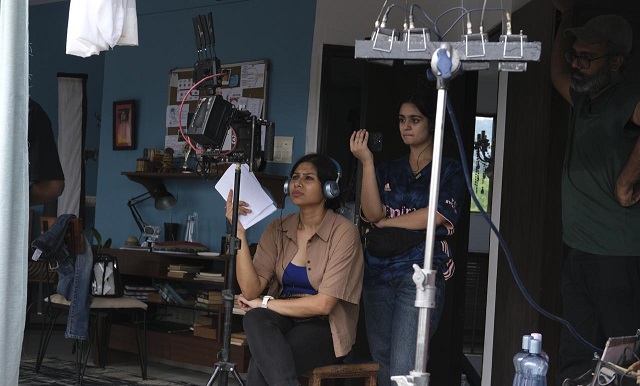
Do you remember what was the first thing you ever painted?
I first picked up a brush when I was maybe around 5 years old. My mum, a painter herself, gave me a watercolor set, a brush, and a drawing book. While I don’t remember the first thing I painted, I do recall the joy of experimenting. She introduced me to creative techniques, like using cut vegetables, ferns, and leaves to make stamp prints. With her Montessori background, learning was always hands-on and playful, making art a natural part of my life.
How would you describe your approach as a painter?
My style as a painter is driven by a deep quest to understand life—both within myself and in the world around me. I find inspiration in my observations, whether they’re of the external world or my inner experiences.
Would you be saying then that painting is a sort of meditation for you?
Yes, absolutely. It calms me, keeps me grounded, and fills me with a deep sense of joy and positivity.
How do you handle creative blocks while creating?
When I hit one, I simply take a step back. I don’t force myself to push through it. Instead, I trust the process. I’ve learned to accept that creative blocks do occur from time to time and I know that the solution will come when it’s meant to. I feel blocks are created by us, and it’s up to us to create the space—mentally and emotionally—for new thoughts to flow and creativity to return.
What themes or subjects do you find yourself painting about often?
The themes I often explore on my canvas reflect my inner journey—my quest to understand life and the principles I try to live by, especially those rooted in yogic philosophy. At the same time, I love bringing in playful elements—characters from nature, animals, humans—and adding my own quirks and stories to them. It’s a mix of reflection and imagination.
Are there any symbols or motifs that you keep returning to in your work?
Yes, polka dots, short lines–both vertical and horizontal, circles, eyes, and floral elements.
Do you follow any rituals before beginning a painting or creating something?
Not a formal ritual, but I do take a quiet moment to connect with the highest before I begin—just like I would before starting any work.
If your inner self could speak directly through your art, what would it say?
It’s actually my inner self that expresses through my art. So in a way, it has already been saying everything it’s wanted to—through every painting so far. Each piece is a quiet conversation, a reflection of what I’ve felt, questioned, or understood in that moment.
What does it feel like to return to a completed piece after time has passed?
It’s like discovering it all over again. I often find new meaning and a fresh perspective that I hadn’t noticed before. It’s as if the artwork continues to evolve with me.
Is there a message or emotion you hope people take away from your work?
I create from a place of personal feeling, but I don’t expect others to interpret my work the same way. Everyone brings their own perspective, and it’s fascinating how different people connect with different aspects of my art. Sometimes, they find meaning in things I hadn’t consciously put there, or see something I may have missed. It’s that diversity of interpretation that makes art so powerful.
How do you honor your feminine energy in your work?
By creating from a space of intuition, sensitivity, and flow. I allow softness, emotion, and stillness to guide my work—without rushing, without forcing.
What has your experience as a women in the creative field been like?
Highly positive, thanks to the selfless support and guidance I’ve received along the way. We’re fortunate to live in a time when women before us have paved the way, allowing us to pursue our passions freely. Though there’s still progress to be made, I’m grateful for the opportunities we have today and hope to contribute to creating an even better world for the next generation of women.
Are there any female artists or mystics who have influenced your path?
I deeply admire the work of Amrita Sher-Gi, Sita Devi and Yayoi Kusama—all powerful in their own unique expressions. I’m a practitioner of Rajyoga, and the principles of this path have profoundly influenced me, not just in life but in how I express myself through art. It’s shaped my perspective, brought depth to my themes, and continues to guide my creative journey.
When do you get into yoga?
I must have been around 7 or 8 years old when I first started. Over the years, different teachers have shaped my journey in unique ways, guiding me through various forms. Currently, I practice Ashtanga yoga with Suveer Balvi ji and Rajyoga at Brahma Kumaris. With time, I’ve come to realize that yoga is more about working on your inner self than just a physical practice. It’s been a gradual understanding, taking years to truly grasp the depth and transformative power of yoga beyond the physical postures.
What are some of the internal shifts you have experienced in the process?
Although I have a long way to go but through these practices, I’ve become calmer, more positive, and less fearful. I’ve learned to be more tolerant and patient, both with myself and others.
Do these practices help during a creative chaos?
Oh yes, absolutely. Yoga brings discipline, cultivates positivity, and helps me stay grounded.
Do you incorporate yogic or meditative philosophies into your artwork?
Yes, yoga is very much a way of life for me, and it naturally seeps into my artwork, be it painting or filmmaking. The stories I write often reflect my own journey and experiences, so, as I live a more aware and conscious life, that awareness inevitably influences what I create. When you’re mindful of your thoughts and actions, it shows in your work, making it more authentic and aligned with your true self.
What does a typical day in your life look like?
I start my day early in the morning with yoga, then spend the rest of it working—reading, writing, painting and/or attending meetings. In the evening, I watch something to unwind before heading to Brahma Kumaris for my meditation class. I usually wrap up by around 10:30 pm.
Of all these practices, which one do you find yourself getting called towards the most?
It’s difficult to choose just one—I find myself drawn to all these practices in different ways. Each one brings something unique to my life. They serve different needs, whether it’s grounding, expression, or reflection, and together they add balance and joy to my everyday life.
Which ones would you say help calm and center you?
Yoga is what truly helps me stay calm and centered. And when that centeredness is in place, everything else—whether it’s painting, writing, or filmmaking—naturally takes on a meditative quality. It all flows from that inner stillness.
What does art feel to you on a soul level?
Art, on a soul level, feels like home. It’s a space of honesty. Where emotions find shape, and stories take breath.
Do you ever feel like your creativity comes from something beyond you?
Yes, often. At times, it feels like I’m just a channel—like something beyond me is flowing through. The best work often happens when I step aside and just allow it to happen.
What does discipline mean to you in your creative and spiritual practice?
Discipline, to me, is essential—it’s the foundation of both my creative and spiritual practice. It brings balance, and a calmer mind, allowing me to show up with clarity and presence each day.

Art, on a soul level, feels like home. It’s a space of honesty. Where emotions find shape, and stories take breath.
Has solitude played a role in your growth as an artist and seeker?
Yes, a big role. It’s helped me befriend myself and truly get to know who I am. Since it’s the inner being that creates, spending time alone has been essential to both my growth as an artist and a seeker.
What’s something you’ve learnt about yourself through your art?
I’ve learned that I enjoy creating the most when I’m not thinking about how others will perceive it. Letting go of that fear is freeing—it makes the process more honest, more joyful, and deeply liberating.
How do you handle moments of self-doubt or inner criticism?
Though I stay aware of them, I don’t let either of the two ever affect me. I remind myself of my journey, practice gratitude, and trust the universe. As for external criticism, I’m okay with it—everyone has a different perspective, and I see it as an opportunity for growth.
How does nature influence your creative and spiritual life?
Nature is both inspiring and healing for me. Its beauty and calm influence my creativity and spirituality, and these themes naturally flow into my work. Being aligned with nature helps me align with the universe, and from that calmness, profound creativity emerges.
What does alignment mean to you in the context of your body, mind, and creativity?
Feeling balanced, alive, and joyful. It’s about living in the moment, being aware, and fully present in both my body and mind.
Have there been any dreams or visions that have influenced your artistic direction?
At times, during meditation, visions of paintings just appear to me. These images or ideas come to me in a moment of stillness, and I later bring them to life through my work.
Do you find that certain times of day or night are more creatively charged for you?
For me, creativity comes at any time depending on my mood and presence.
What is a misconception people often have about artists?
That they are always “inspired” or constantly creating. In reality, creativity takes time, discipline, and effort, and there are periods of silence and introspection before new ideas emerge.
What role has mentorship or guidance played in your evolution?
I have been fortunate to have incredible gurus and teachers in all areas of my life. They help you see what you can’t on your own, recognize your potential, and guide you to sharpen it. Their support, strictness, and values shape you, not only as an artist but also as a better person, teaching you resilience and discipline along the way. I truly owe my growth and learning to their wisdom and support.
What is your creative relationship with imperfection?
Acceptance. I see flaws as part of the process, adding authenticity and depth. At the same time, I work mindfully, taking my time to reach where I want to be.
How do you make space for both discipline and spontaneity in your practice?
I follow a simple routine that gives me structure, but I leave enough room to flow with the moment. Discipline helps me stay grounded, and spontaneity keeps the process joyful and alive. Both are equally important to my practice.
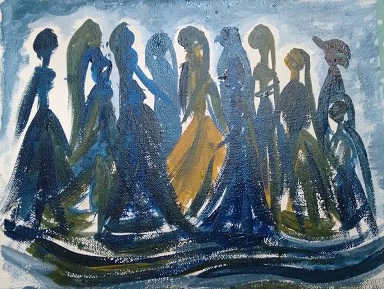
Do you ever feel resistance toward creating?
Yes, that happens at times—it’s usually rooted in fear or self-doubt. I try to gently acknowledge it and talk myself through it, creating space instead of pressure. It often teaches me to slow down, be kind to myself, and trust the process.
Do you think creativity has seasons, like life does?
For me, it flows in its own rhythm—sometimes consistent, sometimes unexpected.
If your younger self could see you now, what do you think she would feel or say?
I think she would smile and say, “We kept following what we loved, even when it wasn’t easy.”
What do you think is the role of an artist in today’s world?
An artist plays the role of a storyteller, a reflector of society, and a catalyst for change. Through their work, they can challenge perspectives, evoke emotions, and bring attention to issues that matter. Art has the power to heal, inspire, and connect us on a deeper level, helping us navigate the complexities of modern life.
What kind of legacy do you hope to leave behind, as an artist, woman and seeker?
I wish to inspire others to find their own path, celebrate their uniqueness, and connect with the world around them in a meaningful way.
What advice would you give to younger woman of this generation?
I would tell them to trust in themselves and their journey. Embrace your uniqueness, follow your passions, and don’t be afraid to challenge norms. Be kind to yourself, stay grounded, and remember that growth often comes through resilience. Most importantly, believe in your worth and always stay true to who you are.
Adria is trained in Odissi dance, classical singing, and Reiqi. She has a deep interest in holistic health, mental well-being, and women’s wellness, and is part of a women’s circle centered on divine feminine energy.
Years ago, she starred in Rukshana Tabassum’s National Award winning children’s film, ‘Apples and Oranges.’ This is Adria’s first published interview, reflecting her passion for healing, expression, and conscious connection.
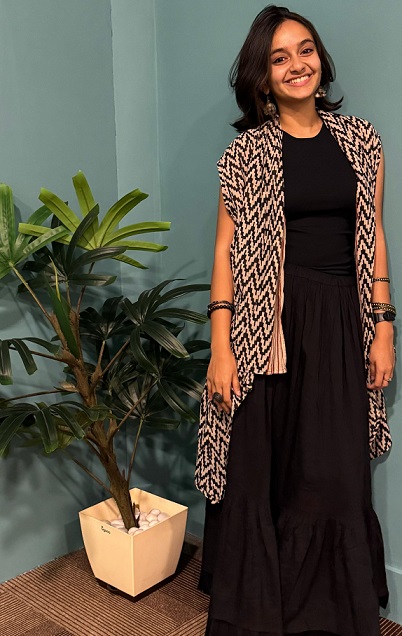
Share Widely

